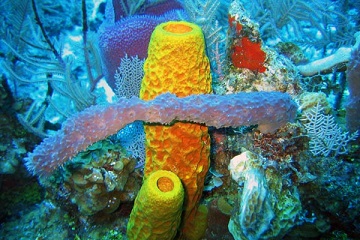Potential of Sponge as the Biogenic Habitat of Soft Animal in Seagrass Field

Seagrass field was a coastal ecosystem having a high biological productivity. Ecologically, this ecosystem acted as the habitat, the area for foraging and also the shelter of various types of the marine life. In the seagrass ecosystem, it had a variety of associative organisms in the form of sponges. The seagrass ecosystem also had a high fertility rate. This could certainly affect the sponge community and the production of the secondary metabolites. The sponge was known to have a wide variety of associative organisms in their body tissues. Therefore, the sponge played an important role as the biogenic habitat that supported the reproduction and the survival of their associative fauna, and it played an important role in maintaining the biodiversity of fauna in the marine ecosystem.
Three researchers from Department of Marine Science and Technology, Faculty of Fisheries and Marine Sciences, Bogor Agricultural University (FPIK of IPB) consisting of Prof. Dietriech G. Bengen, Nyoman Metta Natih, and Meutia Samira Ismet conducted the research on the potential of sponge as the biogenic habitat of the meso-invertebrata (small and invertebrate living creature) in the seagrass ecosystem. The research aimed to study the structure of the meso-invertebrata community of the spongy symbionts and the potential of sponges as the biogenic habitat in the seagrass ecosystem.
From the result of this research, it was found that the sponge would have a higher abundance on the seagrass bed which composed more than one type of seagrass, especially small ones and high density. The sponge community on the fourth observation stations consisted of 23 sponge types with different abundance at each station, dominated by Sp1 and Sp3 sponges, which were thought to be the sponge types of Spirastrella sp. and Agelas conifera. The sponge having the associative mesofauna on the body tissue only amounted to 16 species, of a total of 23 species which were found.
The associative mesofauna found in the seagrass was from the groups of polychaeta, oligochaeta, crustacean, ophiuridea, and gastropoda. The abundance of the associative mesofauna in the spongy body tissue had a close relationship with the inhibitory activity of the spongy body tissue against the pathogenic bacteria (E. coli, S. Aureus, and P. aeroginosa). This was thought to be related to the sponge protection strategy against the pathogenic bacterial infection and on account of the associative mesofauna selected the sponge as the habitat to shelter from the predator and the environmental pressure. (IRM/ris)



